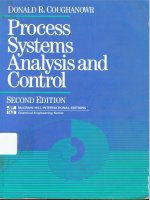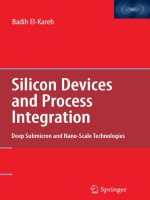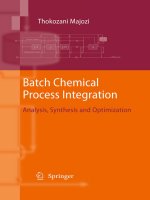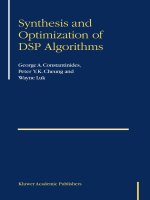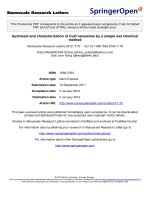batch chemical process integration - analysis, synthesis and optimization dec 2009
Bạn đang xem bản rút gọn của tài liệu. Xem và tải ngay bản đầy đủ của tài liệu tại đây (4 MB, 303 trang )
Batch Chemical Process Integration
Thokozani Majozi
Batch Chemical Process
Integration
Analysis, Synthesis and Optimization
1 3
Prof. Dr. Thokozani Majozi
Department of Chemical Engineering
University of Pretoria
Lynnwood Road
0002 South Africa
ISBN 978-90-481-2587-6 e-ISBN 978-90-481-2588-3
DOI 10.1007/978-90-481-2588-3
Springer Dordrecht Heidelberg London New York
Library of Congress Control Number: 2009939334
© Springer Science+Business Media B.V. 2010
No part of this work may be reproduced, stored in a retrieval system, or transmitted in any form or by
any means, electronic, mechanical, photocopying, microfilming, recording or otherwise, without written
permission from the Publisher, with the exception of any material supplied specifically for the purpose
of being entered and executed on a computer system, for exclusive use by the purchaser of the work.
Printed on acid-free paper
Springer is part of Springer Science+Business Media (www.springer.com)
‘God, Almighty, advance me in knowledge,
understanding and humility’ To all those who
have given and all those who continue to give my
life a sense of purpose.
Foreword
Over the past three decades, process integration has evolved as a holistic approach
to design and operation which emphasizes the unity of the tackled systems. The
overwhelming majority of research publications and textbooks in the field have
focused on continuous systems. This has been the case for two main reasons. First,
until recently, most of the sizable process industries have been designed to oper-
ate in a near steady-state and continuous mode. This is changing given the need
to produce a number of specialty chemical to address variable market needs, the
increasing level of flexibility, and the emergence of new industrial sectors (e.g.,
biorefineries) that favor batch operations. Second, process integration techniques
for unsteady-state operations are more challenging than those for steady-state oper-
ations. As such, contributions to the field of batch process integration have come
from a limited number of researchers. Such contributions have invoked advanced
concepts in process design, operation, and scheduling, network synthesis and anal-
ysis, and some graphical but largely mathematical programming techniques. Hence,
these contributions have been read and utilized by a select few experts. There
has been a clear literature gap. Therefore, it was with great delight that I learned
about Prof. Thokozani Majozi’s project to overcome this literature gap by intro-
ducing this textbook that addresses batch chemical process integration. Having
followed Prof. Majozi’s exciting work in the field, I was convinced that the product
will be superb. Indeed, now that the book is complete and that I had the priv-
ilege of reviewing it in full, I am thrilled that such an outstanding contribution
is now available to researchers, students, and practicing engineers. The book is
very well written and gradually introduces key concepts in batch process integra-
tion including the necessary background in mathematical programming, network
representation, and operational concepts. The book also emphasizes the concep-
tual framework behind many of the mathematical formulations and focuses on the
insights that drive the design, operation, and scheduling strategies. The book is
loaded with examples that streamline the concepts and facilitate the learning pro-
cess. There is a nice spectrum of applications ranging from basic manufacturing
to waste reduction (primarily water management and wastewater minimization) to
vii
viii Foreword
heat integration. This is a much-needed and highly-valued book that will open the
door for many readers to learn the fundamentals and application of batch process
integration.
Dallas, TX Mahmoud El-Halwagi
Preface
Research in batch processes only received heightened interest in the last 2 to 3
decades. Most of the work in published chemical engineering literature tends to
focus on continuous processes at steady state. This occurrence dovetails with the
evolution of the chemical industry as well as the dynamics of the global markets
since the dawn of industrial revolution. From the late nineteenth to the mid-twentieth
centuries, global markets were characterised by reasonable stability and crafted on
bulk demand and mass production which favoured continuous processes. Demand
for small volume high value added products constituted a very small fraction in
that era. This pattern, however, began to change drastically in the latter part of the
last century, with major markets displaying high levels of volatility that required
processes amenable to sudden changes. Batch processes are ideally suited for this
situation. Consequently, research in batch process scheduling began in earnest from
the mid to the late 1970s. Scheduling, which is aimed at capturing the essence of
time, is the cornerstone of all batch related activities, including Process Integration.
Process integration was developed and rose to prominence during the energy
crisis of the 1970s in the form of Pinch Technology. The latter proved to be the
breakthrough in energy optimization and sustainable design. It advocates the explo-
ration of maximum energy recovery within the process through process–process
heat exchange prior to resorting to external utility requirements. Its strength lies
in the ability to set energy targets before commitment to design. Moreover, its
graphical nature allows the designer to guide the optimisation process, which is not
necessarily the case with mathematical approaches. This finally results in an energy
efficient heat exchanger network (HEN). It still remains one of the major advances in
chemical engineering even today. However, this contribution was aimed at continu-
ous processes at steady state and ignored the impact of time dependent interventions
as traditionally encountered in batch processes. This omission was not seen as a
major drawback in process integration within the chemical engineering community,
since continuous processes have largely been perceived to be much more energy
intensive than their batch counterparts. The concept of process integration was later
extended to mass exchanger networks with the ultimate goal of waste minimisation
in 1989 where it also proved to be a major contribution. Again, the focus at the
early stages of this advancement was on continuous rather than batch processes for
similar reasons.
ix
x Preface
Whilst methods for scheduling batch processes advanced steadily throughout the
2 quarters of the last century, process integration aspects pertaining to energy and
waste minimisation still remained largely isolated from the mainstream research.
There were indeed a few contributions in this regard, but their impact remained min-
imal for one main reason. They were largely a direct adaptation of the techniques
developed for continuous processes, which meant that the time dimension had to be
directly or indirectly suppressed in the analysis, thereby resulting in somehow inac-
curate results. Stringent environmental legislation and the growth of batch processes
in the industrial sector have necessitated research on the development of process
integration techniques that are particular to batch processes. Since the beginning
of this century, significant advances have been made in this regard. It is becom-
ing clear, however, that batch processes, unlike continuous processes, are more
amenable to mathematical than graphical analysis. This situation arises mainly from
the added time dimension that makes it difficult to confine batch process analysis to
2 dimensions as traditionally encountered in graphical methods.
This textbook presents a comprehensive overview of some of the milestones that
have been achieved in batch process integration. It is largely based on mathematical
techniques with limited content on graphical methods. This choice was deliberately
influenced by the observation made in the foregoing paragraph, i.e. in order to han-
dle time accurately mathematical techniques seem to be more equipped than their
graphical counterparts. The book is organised as follows.
• Chapter 1 gives an overview of batch processes.
• Chapter 2 introduces the reader to the basis of all the mathematical techniques
presented in this textbook. The mathematical techniques are founded on a recipe
representation known as the state sequence network (SSN), which allows the use
of states to dominate the analysis thereby reducing the binary dimension.
• Chapter 3 presents a synthesis technique for multipurpose batch plants and
further introduces an unexplored operational philosophy so called Process
Intermediate Storage (PIS) operational philosophy.
• Chapter 4 presents a technique for wastewater minimisation in batch plants with
single contaminants.
• Chapter 5 addresses the optimum design of intermediate water storage in
multiproduct and multipurpose batch plants.
• Chapter 6 presents a technique for wastewater minimisation in multipurpose
batch plants characterised by multiple contaminants.
• In Chapter 7 a mathematical technique that takes into account presence of
multiple reusable water storage vessels is presented.
• A near-zero effluent approach is presented in Chapter 8. In particular, this chapter
focuses on a special class of batch plants wherein water is a major constituent of
the final product.
• Chapter 9 presents a mathematical technique for wastewater minimisation
through exploitation of idle processing units, which is a unique and largely
inherent feature of batch plants.
Preface xi
• Heat integration is addressed in Chapter 10 and 11. Chapter 10 focuses on direct
heat integration whilst Chapter 11 on indirect heat integration.
• Lastly, Chapter 12 presents graphical techniques in wastewater minimisation of
batch processes as well as a brief comparison between graphical and mathemat-
ical techniques. The comparison aims to highlight the necessity of time in batch
plants.
University of Pretoria,
South Africa Thokozani Majozi
Acknowledgments
This work could not be brought to life without the help of several people who gave
guidance, assisted with research material and kept me focused throughout the writ-
ing of this textbook. Most of these people are my current and former students who
have worked tirelessly in understanding batch processes. First and foremost, I would
like to thank my recent PhD graduate student Dr Jacques Gouws with whom we
shared a very common vision from the onset of his research. All the seeds of ideas I
shared with him landed on a f ertile ground and grew rapidly to applicable method-
ologies that have been adopted and implemented for industrial benefit. Perhaps in
the s ame league is Mr Thomas Pattinson who put significant effort in the develop-
ment of the formerly unexplored operational philosophy in batch plants, viz. Process
Intermediate Storage (PIS) operational philosophy.
I am sincerely grateful to many of my recent students who had to edit some of
the sections of this book whilst keeping with my demands on their research. In no
particular order, at the fore of my mind in this regard are, Miss Bola Adekola, Miss
Jane Stamp, Mr. Tim Price, Mr. Donald Nonyane, Mr. Vhutshilo Madzivhandila,
Mr Vincent Gololo and Mr Esmael Reshid. Indeed, I am deeply indebted to my
former supervisor, Dr Frank Zhu, who instilled in me love for batch operations and
highlighted the urgency of generating appropriate techniques for these operations.
He is also the one who introduced me to the world of mathematics and always
mentioned that in every step of the way I must never compromise beauty for there
is no permanent place in this world for ugly mathematics – confirming the famous
mathematician Godfrey Harold Hardy’s observation.
I am also deeply indebted to the following people who have offered guidance
in various roles; as mentors, as friends and as family. Professor Ferenc Friedler,
the Dean of Information Technology at the University of Pannonia in Hungary who
has been my longstanding mentor, since I met him i n 2000 in Los Angeles. He
has always been the source of intellectual support and a reliable sounding board to
most of my ideas. My former supervisors, Professor Chris Buckley and Mr Chris
Brouckaert for their faith in me during my very early stages of research. Professor
Toshko Zhelev from the University of Limerick in Ireland who has always had
time to listen, criticise and encourage constructively since our first encounter in
1997 in South Africa. His patience with me still remains unprecedented. Professor
Mahmoud El-Halwagi, the author of the foreword to this book, who I did not
xiii
xiv Acknowledgments
have to meet in person to derive inspiration from him. My true interest in Process
Integration started whilst reading his book on ‘Pollution Prevention through Process
Integration’ in 1997. I read each of its 314 pages with great passion. Mr Thanda
Sibisi, my former science and mathematics teacher, who instilled in me the love and
understanding for these two wonderful subjects and further advised me to pursue
chemical engineering at my most desperate moment. My wife Bongiwe ‘Mabongi’
Dube and my children, Ntsika and Olwanda (the bunnies), who have been very
understanding of my absence even when I am physically in their midst. Lastly,
but certainly not the least, my dear parents who were beginning to understand the
challenges of batch process integration towards the end of writing this book.
Let me not forget the mention of those who have provided fuel for my research
vehicle to propel to the fore – the financial sponsors. Predominant among these
are Dr Sibisi, the President and CEO of the Council for Scientific and Industrial
Research (CSIR), Mr. Cyril Gamede, the Operations Director of African Explosives
Limited (AEL) and Mr. Leon Kruger, the Operations Director of Johnson and
Johnson (Pty) Ltd. My heartfelt thanks also go to the Water Research Commission
(WRC) of South Africa.
Contents
1 Introduction to Batch Chemical Processes 1
1.1 Definition of a Batch Process . 1
1.2 Operational Philosophies . . . 3
1.3 Types of Batch Plants 5
1.4 Capturing the Essence of Time 6
1.5 RecipeRepresentations 8
1.6 Batch Chemical Process Integration: Why Is It Necessary? . . . 9
References 10
2 Short-Term Scheduling 13
2.1 ProblemStatement 13
2.2 State Sequence Network . . . 14
2.3 Mathematical Model 17
2.4 LiteratureExamples 21
2.4.1 FirstLiteratureExample 21
2.4.2 Second Literature Example . . 26
2.5 Application of Aggregation Models in Reducing the
BinaryDimension 33
2.5.1 Second Literature Example Revisited . . 33
2.6 Summary and Conclusions . . 36
2.7 Exercise 36
References 39
3 Process Intermediate Storage Operational Philosophy: The
New Operational Philosophy 41
3.1 The PIS Operational Philosophy 41
3.2 ProblemStatement 44
3.3 MathematicalFormulation 44
3.3.1 Feasibility Constraints 48
3.4 IllustrativeExamples 53
3.4.1 FirstIllustrativeExample 53
3.4.2 Second Illustrative Example . 58
3.5 Industrial Application 61
3.5.1 Computational Results 63
3.5.2 Conclusions and Discussion on the Industrial Application 65
xv
xvi Contents
3.6 Conclusions 65
3.7 Exercise 67
References 67
4 Wastewater Minimisation in Multiproduct Batch Plants:
Single Contaminants 69
4.1 ProblemStatement 70
4.2 Problem Superstructure 70
4.3 Mathematical Model 72
4.3.1 Water Reuse/Recycle Module . 74
4.3.2 Sequencing/Scheduling Module 80
4.4 Objective Function . 84
4.5 LiteratureExample 85
4.6 FirstCaseStudy 88
4.7 Second Case Study . 93
4.8 Concluding Remarks 97
4.9 Exercise 98
References 98
5 Storage Design for Maximum Wastewater Reuse in Batch Plants .99
5.1 The Essence of the Problem . 99
5.2 ProblemStatement 101
5.3 Mathematical Model 101
5.3.1 WaterReuse/RecycleConstraints 104
5.3.2 Sequencing/Scheduling Constraints . . . 107
5.3.3 Additional Constraints 110
5.3.4 Objective Function . 111
5.4 Solution Procedure . 111
5.4.1 Two-Stage Optimisation Algorithm for
Freshwater and Reusable Water Storage Minimisation . 111
5.5 CaseStudy 112
5.5.1 Computational Results 113
5.6 Concluding Remarks 115
5.7 Exercise 116
References 117
6 Wastewater Minimisation in Multipurpose Batch Plants:
Multiple Contaminants 119
6.1 Multiple Contaminant Wastewater Minimisation Background . . 119
6.2 ProblemStatement 120
6.3 MathematicalFormulation 120
6.3.1 Mass Balance Constraints . . . 123
6.3.2 Sequencing and Scheduling Constraints 128
6.3.3 Objective Function . 134
6.4 Solution Procedure . 134
6.5 IllustrativeExamples 135
Contents xvii
6.5.1 FirstIllustrativeExample 135
6.5.2 Second Illustrative Example . 139
6.5.3 LiteratureExample 142
6.6 Conclusions 145
6.7 Exercise 146
6.7.1 A Typical Cleaning Procedure in the Toiletries
MixingArea 148
References 151
7 Wastewater Minimisation Using Multiple Storage Vessels 153
7.1 Multiple Storage Vessel Background . . 153
7.2 ProblemStatement 154
7.3 MathematicalFormulation 154
7.3.1 Superstructure for the Multiple Storage Vessel
Methodology 156
7.3.2 Mass Balance Constraints . . . 157
7.3.3 Scheduling Constraints 161
7.3.4 Objective Function . 164
7.4 Illustrative Examples for the Multiple Storage Vessel Model . . 165
7.4.1 FirstIllustrativeExample 165
7.4.2 Second Illustrative Example . 167
7.4.3 ThirdIllustrativeExample 170
7.5 Conclusions 171
7.6 Exercise 172
References 172
8 Zero Effluent Methodologies 173
8.1 Zero Effluent Operation . . . 173
8.2 Superstructure Used in the Methodology 175
8.3 Zero Effluent Scheduling Model 176
8.3.1 Problem Statement for the Zero Effluent
Scheduling Formulation 178
8.3.2 Mass Balance Constraints . . . 179
8.3.3 Scheduling Constraints 181
8.3.4 Additional Constraints for Significant
Contaminant Mass in the Wastewater . . 186
8.3.5 Objective Function . 187
8.4 Zero Effluent Plant Synthesis Formulation 188
8.4.1 Problem Statement for Synthesis Formulation . 188
8.4.2 ConstraintsConsideredintheFormulation 188
8.5 Illustrative Examples Using the Zero Effluent Mode of Operation 190
8.5.1 FirstIllustrativeExample 190
8.5.2 Second Illustrative Example . 193
8.6 Conclusions 195
8.7 Exercise 196
References 196
xviii Contents
9 Wastewater Minimisation Using Inherent Storage 197
9.1 Inherent Storage Background 197
9.2 ProblemStatement 198
9.3 Mathematical Formulation for Inherent Storage . 199
9.3.1 Superstructure Used in the Mathematical Formulation . 199
9.3.2 Mass Balance Constraints . . . 200
9.3.3 Sequencing and Scheduling Constraints 204
9.3.4 Inclusion of the Maximum Outlet
Concentration Condition . . . 210
9.4 Solution Procedures for the Problems Considered
in the Inherent Storage Methodology . 211
9.5 Illustrative Examples Using Inherent Storage . . 211
9.5.1 FirstIllustrativeExample 212
9.5.2 Second Illustrative Example . 214
9.6 Conclusions 217
9.7 Exercise 218
References 218
10 Heat Integration in Multipurpose Batch Plants: I. Direct
Heat Integration 219
10.1 Some Background to Heat Integration of Batch Plants . 219
10.2 ProblemStatement 221
10.3 MathematicalFormulation 221
10.3.1 Case1:VariableBatchSize 223
10.3.2 Case2:FixedBatchSize 225
10.4 LiteratureExample 227
10.4.1 ResultsandDiscussion 227
10.5 Industrial Case Study 230
10.5.1 ResultsandDiscussion 231
10.6 Conclusions 233
10.7 Exercise 234
References 234
11 Heat Integration in Multipurpose Batch Plants: II. Indirect
Heat Integration 235
11.1 ProblemStatement 235
11.2 Mathematical Model 236
11.3 CaseStudy 241
11.4 Results 242
11.5 Conclusions 244
11.6 Exercise 245
References 245
Contents xix
12 A Graphical Technique for Wastewater Minimisation in
Batch Processes 247
12.1 Introduction 247
12.1.1 Wang and Smith Approach for Water
MinimisationinBatchProcesses 249
12.2 Graphical Analysis for Completely Batch Processes . . . 254
12.2.1 ProblemStatement 254
12.2.2 TimeTakenasaPrimaryConstraints 254
12.2.3 Concentration Taken as a Primary Constraints . 263
12.3 A Brief Comparison Between Graphical
and Mathematical Approaches 269
12.4 Concluding Remarks 272
12.5 Exercise 272
References 272
Index 275
Chapter 1
Introduction to Batch Chemical Processes
Overview Batch processes are mostly suited to low volume high value added prod-
ucts that are usually characterised by common recipes, which render them amenable
to sharing of equipment units. Due to their intrinsic adaptation to s udden changes
in recipe, they are processes of choice in volatile or unstable conditions that have
become regular in global markets. This chapter provides the background informa-
tion on batch chemical processes, which constitutes the basis for the forthcoming
chapters. Only the essential elements of batch plants are captured with references,
where necessary, to further sources of information for the benefit of the reader.
1.1 Definition of a Batch Process
Any process which is a consequence of discrete tasks that have to follow a pre-
defined sequence from raw materials to final products is a batch process. This
predefined sequence is commonly known as a recipe. The primary features of any
comprehensive recipe are the quantities of materials that have to be processed by
individual tasks as well as the duration of each task within the recipe. The secondary
features are the operating conditions of the various tasks, and in less common cir-
cumstances, the locality or geographic position of the task at hand. In processes
wherein safety is of great concern, it might be necessary to perform a particular task
in a designated area equipped with relevant safety features.
In reality, it is the discreteness of tasks that differentiates batch processes from
their continuous counterparts. To illustrate, Fig. 1.1a shows a typical batch reactor
with all the tasks comprising the entire batch reaction. On the other hand, Fig. 1.1b
depicts a typical continuous reactor at steady-state. The discreteness of tasks in
Fig. 1.1a is evident, which is not the case in Fig. 1.1b. Consequently, it is fair to deem
batch processes ‘distributed in time’, whilst continuous processes, at steady-state,
are ‘frozen in time’.
Another illustration for the distinction between batch and continuous process is
depicted in Fig. 1.2. The discreteness of tasks that characterise a batch process is
evident in Fig. 1.2a. The use of storage becomes necessary when the completion of
1
T. Majozi, Batch Chemical Process Integration, DOI 10.1007/978-90-481-2588-3_1,
C
Springer Science+Business Media B.V. 2010
2 1 Introduction to Batch Chemical Processes
Fig. 1.1 (a) Batch vs (b) continuous reaction
Fig. 1.2 (a) Batch vs (b)
continuous process operation
1.2 Operational Philosophies 3
one task does not coincide with the commencement of the next task in the recipe.
This condition, which is a regular occurrence in batch plants, mainly arises from
the unavailability of processing equipment units. A processing equipment unit is
only available once it has completed all the previous tasks. Moreover, the inclusion
of storage is invariably concomitant with flexibility in the operation of the plant,
which is likely to increase throughput or even minimize the makespan. On the other
hand, over a given time horizon, a continuous process, at steady state, would exhibit
the behaviour shown if Fig. 1.2b. The feature of batch processes shown in Fig. 1.2a,
commonly known as the Gantt chart, implies that a proper design of the batch plant
requires exact treatment of time, since each task is time dependent. In a nutshell,
the optimum capacities of each of the equipment units are inextricably linked to
the optimum schedule. Consequently, in order to properly design a batch plant, one
cannot overlook nor disregard the underlying schedule. Again, this does not feature
in continuous operations.
1.2 Operational Philosophies
In the analysis, synthesis and optimization of batch plants complexity arises from
the various operational philosophies that are inherent in time dependent processes.
In a situation where the intermediate is allowed to wait in the same unit from which it
is produced until the next unit is available, the operational philosophy is commonly
known as no intermediate storage (NIS) operational philosophy. This philosophy is
depicted in Fig. 1.3. NIS operational philosophy is usually adopted if operational
space is of essence, since intermediate s torage tanks can occupy considerable area.
Intermediate storage is usual the most obvious means to debottleneck the batch
process and introduce flexibility. In general, 3 operational philosophies take advan-
tage of intermediate storage in rather distinct ways. The first is the finite intermediate
storage (FIS) operational philosophy, depicted in Fig. 1.4. FIS operational philoso-
phy stipulates that the intermediate is stored prior to the next step in the recipe. The
storage of intermediate material could be due to capacity or time related issues. If
the capacity of the source of the intermediate is larger than the capacity of the sink,
storage might prove necessary so as to contain all the material within the process.
On the other hand, as mentioned earlier in this chapter, if the completion time of
Fig. 1.3 No intermediate storage (NIS) operational philosophy
4 1 Introduction to Batch Chemical Processes
Fig. 1.4 Finite intermediate storage (FIS) operational philosophy
one task does not coincide with the starting time of the subsequent task, an interme-
diate storage unit can be used to debottleneck the process. The finiteness of storage,
as the name of this philosophy suggests, emanates from the fact that the availabil-
ity of storage capacity is not guaranteed. This implies that there could be instances
within the time horizon of interest when the storage unit is filled to its capacity and
consequently unavailable for further storage.
The second operational philosophy that exploits intermediate storage is the
unlimited intermediate storage (UIS) operational philosophy. This philosophy is
similar to FIS philosophy, except that the availability of storage is always guaran-
teed. The implication thereof is that whenever the intermediate material is produced
it can immediately be stored without limitations or constraints on storage capac-
ity. In practical terms, this can be achieved if the capacity of storage is too large
compared to the capacity of production units as shown in Fig. 1.5.
The third philosophy that makes use of intermediate storage is common inter-
mediate storage (CIS) operational philosophy, shown in Fig. 1.6. CIS philosophy
involves the sharing of storage by various tasks within the batch plant. Needless
Fig. 1.5 Unlimited intermediate storage (UIS) operational philosophy
